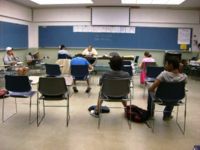Difference between revisions of "Individually Paced Mathematics Sequence"
m |
|||
| Line 21: | Line 21: | ||
[[Category:Courses]] | [[Category:Courses]] | ||
| + | [[Category: Amherst]] | ||
[[Category: Baltimore (JHU)]] | [[Category: Baltimore (JHU)]] | ||
[[Category: Claremont]] | [[Category: Claremont]] | ||
Revision as of 15:40, 26 July 2018
Individually Paced Mathematics Sequence, often shortened as Math Sequence, is a very unique Math course in the CTY program. Math Sequence is a school-curriculum oriented math course, and is intended to enable students to skip a year of math in school. Its course code is MATH, and it is offered at Baltimore. It was previously offered at Lancaster, and Saratoga Springs.
Course Description
Math Sequence is different from every other course at CTY in its flexibility and adherence to individual students' needs. On the first day, students in Math Sequence, instead of settling into their dorms as usual, take a 2 hour long placement test. The first day, students are given a large packet of math problems and told to begin. From then on, all they do is work on these problems, only speaking with the instructor if they have a question. Students are not given much freedom in the classroom, and although the work is straightforward and often boring, diversions are sometimes made in class and students may progress at their own pace.
Not surprisingly, Math Sequence has a reputation as the course students' parents make them take.
Class History
SAR.08.2 will remember our werewolf TA and Dammy the SOURCE Adeoti
JHU.09.1 will remember our crazy teacher Mrs. Mishra and our cool TA Jim who always made fun of her behind her back
JHU.10.1: Hi TA Leah, from Rowan, Peter and Rudy from the train!
JHU.11.1 will always remember the train formula. We also will always remember why moons are on wizard hats (even if we never found out the reason why stars were). Hi Keith and Cynthia! We miss you!
Note that at the last social, students who have participated in this course are often seen having emotional breakdowns over asymptotes. One should not take this course unless one has a strong grasp of reality, because after 3 weeks of algebra, you might start talking to numbers. It happened to me; after this course, I developed a form of synesthesia which makes every number from 1 through 99 have a specific personality, and zipcodes are entire pictures. Now I am a freshman in Pre-Calculus and the seniors scare me. Also, the test can take quite a bit longer than 2 hours. More like four. No offense, but this is a really boring class also.
